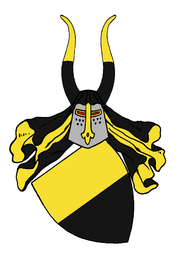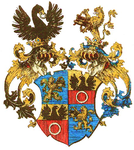Pfinzing von Henfenfeld
The Pfinzing von Henfenfeld were one of the oldest patrician families in the imperial city of Nuremberg . They are first mentioned in a document in 1233 and were represented in the inner council from the beginning of the council records in 1274 until their extinction in 1764 . This made them the oldest Nuremberg council family. According to the dance statute of 1521, they belonged to the twenty old genders eligible for advice. In 1764 they went out.
history
The Pfinzing (also: Pfintzing ) came from the Reichsministerialität around Nuremberg and were first mentioned in 1233 with Sifridus de Nurinberc , called Pfincinch , in a document from the Heilsbronn monastery. The family was one of the most important Nuremberg patrician families .
The Pfinzing had occupied the office of Reichsschultheissen several times as early as 1274 and were a power factor in the wide-ranging Nuremberg trade policy in the 14th century. Our own trading activities in Southeastern Europe, in Italy and as a partner in Stromer's trading company are also documented early on. Bertold Pfinzing († 1405), Ulrich Stromer's son-in-law, was King Wenzel's advisor and financier . His son, Sebald Pfinzing († 1431), also played a major role in politics. Together with Peter Volckamer , he was the most important Nuremberg liaison to King Sigismund in 1411/31 and at that time one of the richest citizens of the city. In the 16th century the Pfinzing owned a wide-ranging trading network with bases in Venice, Salzburg, Augsburg, Regensburg, Leipzig and Breslau, among others. They traded in textiles and spices, were involved in the Schlaggenwald tin trade and, above all, in the Mansfeld iron and steel trade . They did business with iron ore mining and processing in the Upper Palatinate and owned their own Seigerhütte in Ludwigsstadt (Upper Franconia) . The Pfinzing, together with the Imhoff , Tucher and Welser , were among the last patrician long-distance traders. Together with Hans Welser, Martin II Pfinzing (1521–1572) was elected as the first lord of the market to the trading board of the Nuremberg Stock Exchange .
The wealth of the Pfinzing was documented in numerous possessions in and around Nuremberg. In 1530, Martin I Pfinzing (1490–1552) bought the ancestral seat of Burg Henfenfeld from the Egloffsteins and named his line Pfinzing von Henfenfeld after the village of the same name . The addition to the name was recognized as a title of nobility and confirmed by an improvement in the coat of arms in 1554 .
The Henfenfeld main line of the sex died out with the Reichsschultheissen Johann Sigmund Pfinzing von Henfenfeld (1712–1764). Heirs were the Hallers von Hallerstein .
Branch lines of the family were: the Nuremberg Line († 1598), the Pfinzing von Weigelshof († 1617) and the Pfinzing von Gründlach († 1739)
Former possessions (extract)
Until 1445, their Nuremberg parent company was what would later become the “Fürershof” at Maxtor (today the area of the old building of the Johannes-Scharrer-Gymnasium ). From 1530 to 1764 (family foundation until 1817) they owned the eponymous headquarters in Henfenfeld and also:

- ???? - 1304 Unterdeutenbach (near Stein)
- 1281 - ???? Schwabach (as a deposit)
- 1304–1384 Oedenberg
- 1325 - ???? Neuendettelsau
- 1330 - ???? Steinbühl (?)
- ???? - 1360 the Burgfriedschlösschen in Sündersbühl
- ???? - 1370 Zerzabelshof
- 1377–1575 Lichtenhof
- 1378–1393 the Hallerweiherhaus in Gleißhammer
- ???? - 1370 the Röckenhof manor house
- 1398–1764 Güntersbühl (from 1617 family foundation)
- ???? - 1405 Harsdorf Castle in Fischbach
- 1398–1764 Nuschelberg
- 1405 - ???? the Oberschöllenbach manor
- 1413–1432 Wolfsfelden near Kalchreuth (as pledge of the burgraves)
- 1413–1432 Erlangen (as pledge from the burgraves)
- 1455–1469 the Pfinzingschloss in Feucht
- 1463-1482 Malmsbach
- 1463-1490 Maiach
- ???? - ???? (around 1500) the stone house in Dormitz
- ???? - 1572 the Wunderburg estate near Marloffstein
- 1510–1551 Lichtenegg
- 1548–1561 a manor in Bruck (Erlangen)
- 1561–1595 the Petzsche Castle in Schwarzenbruck
- 1566-1739 hypocrite
- 1520–1739 (approx.) The Weigelshof manor (Weigelshof line until 1617)
- 1573-1629 Latvians
- 1590–1764 the Pfinzing Castle in Wendelstein
- 1591–1711 the Red Castle in Heroldsberg
- 1600–1627 the Baderschloss in Mögeldorf
- 1607–1764 the Hallerschloss in Nuschelberg
- ???? - ???? (around 1614) Kleingeschaidt
- 1623–1663 Happurg
- 1616–1764 the rule of Großgründlach (Gründlacher line until 1739)
- 1625–1714 the manor in Weiherhaus
- 1680–1688 the Birnthon manor
- as well as the Käswasser and Kalchreuth forest hubs.
Foundations (extract)
- Pfinzing Chörlein at the Sebalder rectory (Melchior Pfinzing, 1514)
- Pfinzing Clothing Foundation (Seyfried Pfinzing, 1617)
- One of the Nuremberg lake houses
Known family members
- Melchior Pfinzing (1481–1535), provost of St. Sebald and editor and co-author of Theuerdank
- Paul Pfinzing the Elder (1554–1599), councilor, merchant and cartographer, creator of the Pfinzing Atlas
Melchior Pfinzing (1481–1535), by Hans Schwarz
Paul Pfinzing (1554-1599)
Paul Topler and Martin Pfinzing (by Albrecht Dürer , 1520)
coat of arms
The coat of arms , originally taken over by the Geuschmid family from Nuremberg around 1300 (formal imperial approval for this in 1465) and since then carried by the Pfinzing, shows a shield divided into gold over black. On the helmet with black and gold covers two buffalo horns marked like the shield. The original coat of arms of the Pfinzing family, however, is said to have been divided by gold and red, with a black eagle above and a silver ring below. Fritz Pfinzing , (* around 1276; † between 1327/1331) in Nuremberg, mentioned 1303–1327, was a jury nurse of the infirmary near St. Johann. He was married to Elsbet Geuschmid (* around 1280/1285), the daughter of Berthold Geuschmid (* around 1255/1260; † 1331), mentioned in Nuremberg in 1290. Fritz Pfinzing's father-in-law Berthold Geuschmid was again the son of a Pfinzing, from Elisabeth (* around 1245). Fritz Pfinzing finally dropped the old Pfinzing family coat of arms (around 1300) and adopted the Geuschmid coat of arms: "Gold and black divided". (Cf. Pfinzingsche Ahnentafel in: Der Pfinzing-Atlas von 1594, StsA Nürnberg 1994.) In the following centuries there was some ambiguity as to what the Pfinzing's actual family coat of arms was, so that in Siebmacher at the beginning of the 18th century the Geuschmid was wrongly used the original coat of arms of the Pfinzing was assigned. (See illustration.)
(After improvement of the coat of arms in 1554) divided into four : Fields 1 and 4 divided by gold and black (allegedly once the coat of arms of the Geuschmid), 2 and 3 divided by gold and red, above a black eagle above, below a silver ring (allegedly originally the coat of arms of the Pfinzing) , covered with a heart shield divided by gold, blue and silver († von Henfenfeld ).
Historical coats of arms
Alliance coat of arms of the Pfinzing and Peringsdörffer (1531)
Coat of arms of the Pfinzing in Siebmacher (around 1600)
Epitaph in the Sebaldskirche
See also
- List of German noble families / P
- Patriciate (Nuremberg)
- History of the city of Nuremberg
- List of castles, palaces and manors in Nuremberg
Individual evidence
- ↑ The Holzschuher is mentioned in a document as early as 1228, but it was not until 1319 that they were included in the Inner Council and thus in the patriciate. The Stromer first mentioned in 1230 followed in the council in 1291, the Schmugenhofer in 1291 (extinguished in 1469), the Stein in 1291 (extinct in 1395), all other patrician families only after 1300. The Waldstromers mentioned in 1230 did not even join the council until 1729.
- ^ Richard Ehrenberg: The old Nuremberg stock exchange. In: Communications from the Association for the History of the City of Nuremberg. Volume 8, Nuremberg 1889, pp. 82-83.
- ↑ Friedrich Mayer: Nuremberg's trade and industry: With special consideration of the present. Nuremberg 1852, p. 53.
- ↑ The story of Neuendettelsau ( Memento of the original from March 12, 2016 in the Internet Archive ) Info: The archive link was inserted automatically and has not yet been checked. Please check the original and archive link according to the instructions and then remove this notice.
- ↑ Bernhard Peter, Gernot Ramsauer, Alex Hoffmann Gallery: Photos of beautiful old coats of arms No. 1477 -Nürnberg (Middle Franconia): St. Jakob in Nuremberg (2) swear shields of the German Order .
- ^ Franconian coat of arms: Pfintzing / Pfinzing von Henfenfeld .
- ^ Fritz Pfinzing in Nuremberg .
- ↑ The family of those from Oelhafen and the manors in Eismannsberg .
literature
- Christoph von Imhoff (Hrsg.): Famous Nuremberg from nine centuries. Nuremberg: Hofmann, 1984, 425 pages, ISBN 3-87191-088-0 ; 2., erg. U. exp. Edition, 1989, 459 p .; New edition: Edelmann GmbH Buchhandlung, October 2000.
- Mr. Bertold Haller von Hallerstein: Pfinzing von Henfenfeld, patrician family . In: Michael Diefenbacher , Rudolf Endres (Hrsg.): Stadtlexikon Nürnberg . 2nd, improved edition. W. Tümmels Verlag, Nuremberg 2000, ISBN 3-921590-69-8 ( online ).














